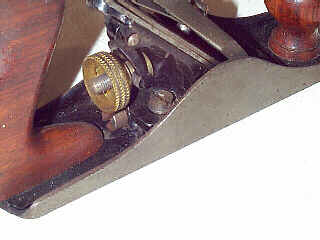
John Shaw was to Sargent&Co. as Edmund Schade was to Stanley; i.e. he was one of Sargent's idea men, whose innovations were crucial for his company's hope to battle the big kid on the block, Stanley. Sargent & Co. was one of Stanley's largest rivals and operated (stilll does) south of New Britain, CT, Stanley's turf, in New Haven, CT. Sargent &Co. had built its reputation on hardware, and now set its sights on manufacturing tools for the woodworking trade.

Shaw was assigned three patents during his tenure with Sargent&Co. His first, a lateral adjustment mechanism which allowed the plane's iron to be tilted from side-to-side (to accomodate the minor deviance of the cutting edge being off from the desired 90 degrees to the cutter's sides) was granted February 7, 1888. This was also Sargent's first plane patent, and was a necessary one since Stanley had quickly applied their patented design of the same adjustment feature to their Bailey planes ca. 1885.
Shaw's next patent was assigned July 3, 1906 for an adjustable frog that didn't first require the removal of the lever cap and cutter assembly to accomplish the task.
His final patent, of October 29, 1907, called for an adjustable plane tote (handle) that could be tilted from side-to-side and secured in a postion the workman found comfortable. Edmund and Albert Schade (the father and son Stanley tag-team) had patented a similar tote on April 11, 1905, and offered it on their company's #10 1/4 rabbet plane. It seems as though there was a mad-rush to design the best tilting tote, where each company thought (or perhaps could hoodwink 'em) that a public long-starved of such a gizmo, would line-up like lambs to a slaughter and mindlessly purchase whatever was tossed before them. None of the tilting totes ever proved to be that popular, and when reviewing the history of planes, it's obvious that these totes were just a passing fad.
It's Shaw's second patent which is the most clever, and the one that gained him some fame, at least among the collectors of woodworking tools. His idea of an adjustable frog is better than Stanley's since it doesn't change the irons set - it moves horizontally relative to the sole and not at an angle like the Bed Rock design. The big knock against Shaw's design is that that the screws used to adjust the frog are a pain in the arse to get at with a screwdriver, especially on the smaller sizes of the plane, like the #2 and #3.
For another look at an interesting Sargent&Co. plane, check out their version of the #62, the No. 514.
Copyright (c) 1998-2012 by Patrick A. Leach. All Rights Reserved. No part may be reproduced by any means without the express written permission of the author.